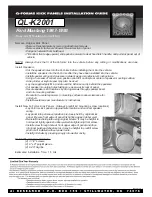
10
S
ett
ing
S
ubwoofe
r
Levels
Once the subwoofer is in position, its level needs to be matched with the near-field
monitors. For stereo systems, the process is straightforward. Obtain a SPL (Sound Pressure
Level) meter. If you will be using the internal high-pass filtered outputs from the subwoofer
to the near-field speakers, set the low-pass filter on the KRK subwoofer back plate to 80Hz.
Now, route 1-octave wide, band-pass pink noise to the monitor system, which will be sent
to the main speakers through the subwoofer or bass-management filters. A good choice is
500 to 1,000Hz band-passed pink noise, which is within the fundamental frequency range
of many vocalists, and minimizes high-frequency problems but doesn't excite the
subwoofer. Set this to a comfortable monitoring level (typically 85dB SPL using the
C response curve on the SPL meter).
Next, route 1-octave wide, band-passed, bass pink noise to the subwoofer via the same
filter path. A good noise choice is 35 to 70Hz, which is below the 80Hz frequency of the
subwoofer high-pass filter, but sufficiently high enough that most subwoofers will have
adequate response in that band. Set the gain of the subwoofer level control until it
matches the same 85dB SPL level.
Turn up the low-pass filter control on the subwoofer to 130Hz. This allows the bass
energy between the near-field monitors and subwoofer to overlap. While listening to it from
the mixing position, route pink noise with a band-pass of 60 to 120Hz to the
speaker system. Have someone flip the phase switch between 0 and 180 degrees, and then
back, and note which position sounds loudest. The loudest position is correct and in phase.
Now return the low-pass filter to the 80Hz position (or another frequency if you are using
external high-pass filters for the near-field monitors). Your subwoofer should now be
properly aligned for phase, level and spectral response.
U
s
ing
the Byp
a
ss
F
e
a
tu
r
e
Your KRK subwoofer is equipped with a by pass feature which allows you to defeat the sub
and provide full range audio to your recording monitors in instances where your Line Outs
are being utilized. This feature is of great benefit in that the high-pass filter is bypassed
allowing full bandwidth to run to the monitors while muting the sub. This allows you to
evaluate the impact of the subwoofer on your mix. Plug in a standard quarter-inch, mono,
latching footswitch to the female quarter-inch connector on the back panel. Any standard
latching quarter-inch mono footswitch (such as the Boss FS-5L) should be compatible.








































